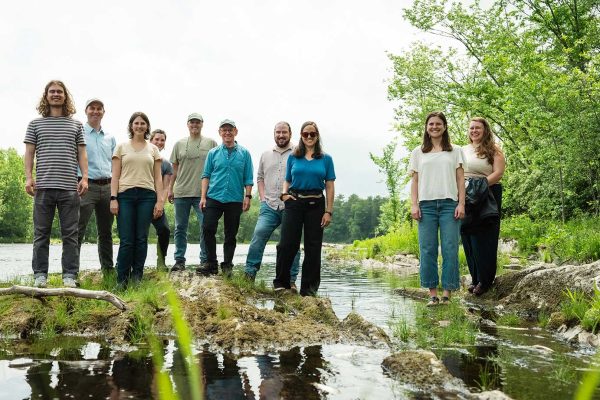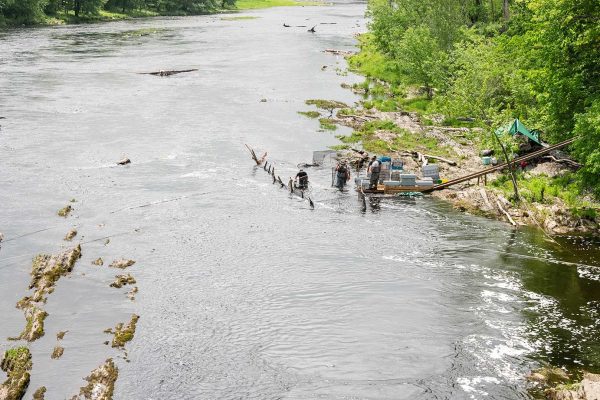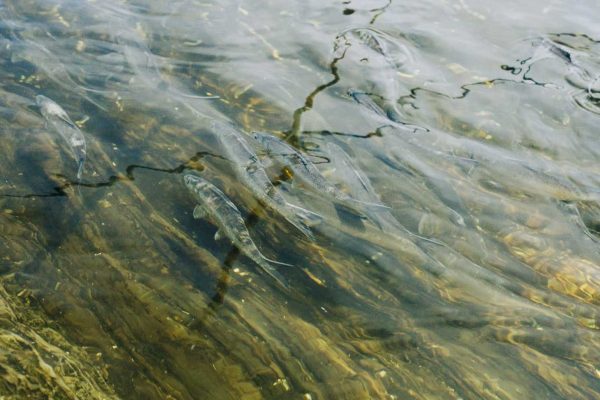At the end of May we were lucky enough to join our colleagues on a field trip to the Benton Falls Dam on the Sebasticook River to see the alewife (river herring) run. Alewives spend the majority of their lives in the ocean and only follow freshwater routes to spawn in interior lakes and ponds in the spring. The massive alewife run in the Sebasticook, a tributary of the Kennebec River, is the result of decades of dedicated work by the staff at Natural Resources Council of Maine (NRCM) who came before us and made an impact in the real world.

Some NRCM staff members spent the afternoon at Benton Falls (Photo by SToomey/NRCM)
The Benton Dam has a fish lift installed – not a fish ladder, like we initially imagined, but a true lift (or elevator) that allows fish to swim into a compartment that raises them up to the top of the dam where they are then shuttled into a corridor of flowing water to the lake on the other side.
It was truly a spectacular experience to see hundreds of these silvery scaled alewives using their incredible prowess as swimmers to propel themselves down the human-made channel to reach their spawning destination on the other side.
This spectacle would have been impossible to see in the early 2000s. There was no fish passage on this dam and the Fort Halifax Dam further down river created hurdles too large for these fish to traverse.
We listened with rapt attention as we learned more of the history of this incredible project and the river’s restoration that was led by NRCM and our partners in the Kennebec Coalition. When the lift was initially installed, there was just a fraction of the fish using it – around 500,000 passed through in 2008, the year before the installation of the lift and removal of the Fort Halifax Dam. Compare that to 2024 where researchers counted more than 6.4 million alewives on the way to their spawning habitat.
On the day we visited, there were at least six eagles either circling or perched in branches overlooking the river. We marveled as one by one eagles would swoop from their perch to dive toward the water. At times, one was successful, as evidenced by the flash of silver in its talons as it flew back to a branch to enjoy the fruits of its labor. It was hard to imagine this scene not existing only a few decades prior.

Fishermen on the river, harvesting alewives. Photo by SToomey/NRCM
Navigating the fish lift and evading the reaching talons of eagles were not the only challenges the alewives faced this day on their journey upstream. A small section of the river below the dam was enclosed with a system of nets where fishermen drove the alewives inward, to then be scooped up and stocked in crates.
The alewife harvest in Benton is a unique way for the fishermen of Maine to have access to local, affordable, and sustainable bait. They catch a small number of the fish, pay a portion to the Town of Benton, then sell them up and down the Maine coast, and even up into parts of Canada. In the 15+ years that they have been harvesting alewives, the fishermen have seen the true impact that habitat restoration can have on just one fish species after the removal of the Fort Halifax Dam. The growth of the alewife population continues to flourish, and the vibrancy of the ecosystem is evident in many ways we were able to observe on our brief excursion.
The entire experience was eye-opening, fascinating, and suggested the sublime in watching nature not only act as it should, but thrive. It got us thinking about what conservation means to us, and additionally, what does it mean to be a steward of the land?

Alewives swimming in the river. Photo by SToomey/NRCM
In a time where we are increasingly isolated and polarized as a country and state, conservation seems to be one of the few areas where folks from differing ends of the political spectrum have crossover. Though motivations may be different, everyone wants healthy rivers, healthy waters, and healthy ecosystems for our native species to thrive.
Conservation and stewardship of the natural environment means knowing the work we do now, while often seemingly thankless in the moment, will have true and lasting impact on those in the future. We are reminded of an adage: “Blessed are old people who plant trees knowing that they shall never sit in the shade of their foliage.” To us, conservation and environmental stewardship is not only believing these words but living them to the fullest in our everyday pursuits.
As we saw and felt during our brief visit to the healthy and thriving Sebasticook River, the impacts of the selfless work we do now for those we may never know or see, will be felt in perpetuity by those who come after the work is done. As Jimmy Carter once said, “Like music and art, love of nature is a common language that can transcend political or social boundaries.”
For us, it is on to the next conservation project — Reuniting the Kennebec — that we hope will result in similar breathtaking moments for future generations.
—Ben Wyman, NRCM Administrative & Operations Associate and Sierra Toomey, NRCM Digital Content Producer
You can also watch this short video from our trip:










Leave a Reply